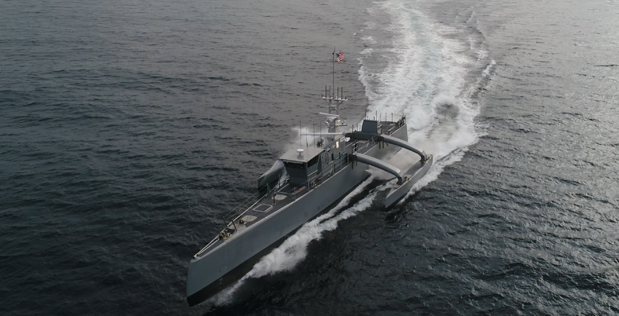
The Sea Hunter, an experimental unmanned submarine-hunter.
WASHINGTON: The Navy is scrambling to write its new acquisition and operational playbook on the fly, a decision based as much on what US rivals are doing as it is on what the service hasn’t done in recent decades.
The construction and innovation booms being undertaken by the Chinese — and to a lesser extent Russian — navies, are forcing the admirals at the Pentagon to push new, still mostly theoretical, unmanned technologies into the water as quickly as possible for urgent make-or-break tests.
The biggest gamble — with potentially the highest payoff — is the $3.7 billion worth of unmanned programs the service included in its 2020 budget submission. The spending includes $447 million to buy two large unmanned surface vehicles that can provide a variety of missions from long-range surveillance to offensive operations.
After the 2020 budget, the Navy plans to buy two LUSVs a year until 2024, for a total of about $2.7 billion. The Navy is making plans to buy 232 unmanned platforms of different sizes and configurations over the next several years.
The hulls the the LUSV should be about 200- to 300-feet long, and weigh 2,000 tons and eventually carry vertical launch cells that would give the emerging Ghost Fleet real combat punch, Navy leaders have said.
But most key questions over how these unmanned ships will be controlled, by who, and if they will deploy independently or as part of traditional strike groups, have yet to be answered.
Announcing these huge investments without a corresponding operational plan is “an expression of the urgency the Navy is attaching to the situation” of trying to stay operationally unpredictable while keeping ahead of the Chinese and Russian, Ronald O’Rourke, the top naval analyst at the Congressional Research Service, told an audience Monday at the Heritage Foundation.
The big spending on unmanned systems before many core questions are answered “is emblematic of where some acquisition may be heading in the coming years — there is a feeling that in the new era of renewed great power competition, we no longer have the luxury of time so we have to move quickly and be prepared to make decisions in the absence of complete or perfect knowledge,” he said.
O’Rourke’s assessment is in line with written testimony Navy leaders submitted to the Senate Armed Services Committee earlier this month.
“China is innovating faster than we are and fielding significant warfighting capabilities,” the statement said. “To address the pace at which they are progressing we cannot continue to develop weapon systems under a procurement acquisition system with its foundations from the Cold War.”
While plans are great, explaining to lawmakers, industry and the public just what those plans might mean to them is more difficult. The Navy “needs to socialize for various audience that we’re going to have failures,” as these programs move forward quickly, and continue to change, said Eric Labs, appearing alongside O’Rourke at Heritage.
“If they don’t do that socialization as part of the acquisition process many people might draw parallels to the LCS program,” which has suffered years of criticism — much of it earned — as it slogged through different operational concepts and technology failures.
That’s something the Navy doesn’t want to see happen to its nascent Ghost Fleet of unmanned ships, which it wants to get into the water quickly — even before it fully fleshes out what it wants to do with them.
Navy jet trainer fleet operations remain paused after engine mishap
One week after the incident, a Navy spokesperson says the service is continuing to assess the fleet’s ability to safely resume flight.


























